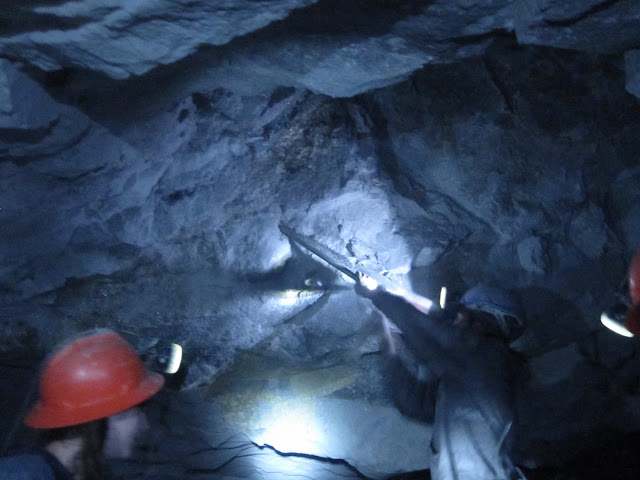I had heard lots about the mines in Potosi from other travelers that I met so I was curious to see them for myself. Most people were shocked at the conditions but yet most people enjoyed the visit. Here are some quotes from the lonely planet guidebook:
"A visit to the cooperative mines is demanding, shocking and memorable but potentially dangerous"
"The cooperative mines are not museums, but working mines and fairly nightmarish places."
"Working practices are medieval, safety provisions nearly non-existent and most shafts are unventilated"
After a hellish night bus from La Paz we arrived in Potosi around 6am, luckily the hostel has spare beds and let us checkin immediately. The night bus was freezing and so was Potosi.
Almost everyone in Potosi seemed to be a tour operator so we checked out a few to see what they were offering. Tour prices ranged from 60 to 100 bolivianos for what appeared to be the same tour. We questioned most operators about how much money from the tour actually went to the mine cooperative and also about their use of dynamite. Most people lied about how much money went to the cooperative although one company we came across was honest about it. I can't remember the figures but it was an extremely small amount less than 5%.
The issue of dynamite blasts was also interesting, we weren't interested in dynamite blasts (due to environmental reasons and also that they are banned for the health and safety of the miners) so were looking for a tour company that wasn't offering it. Dynamite is actively used in the mines but only when it is required not as a show for tourists. That said some companies that we asked assumed we wanted dynamite blasts so they went to get lengths to explain how great their dynamite blasts would be.
 |
| Potosi |
Almost everyone in Potosi seemed to be a tour operator so we checked out a few to see what they were offering. Tour prices ranged from 60 to 100 bolivianos for what appeared to be the same tour. We questioned most operators about how much money from the tour actually went to the mine cooperative and also about their use of dynamite. Most people lied about how much money went to the cooperative although one company we came across was honest about it. I can't remember the figures but it was an extremely small amount less than 5%.
The issue of dynamite blasts was also interesting, we weren't interested in dynamite blasts (due to environmental reasons and also that they are banned for the health and safety of the miners) so were looking for a tour company that wasn't offering it. Dynamite is actively used in the mines but only when it is required not as a show for tourists. That said some companies that we asked assumed we wanted dynamite blasts so they went to get lengths to explain how great their dynamite blasts would be.
Eventually we settled on 'The Real Deal' as our tour guides. These guys were all ex-miners, well most tour companies claimed to be ex-miners but these guys actually were and had photos, references and family members to prove it.
The tour started with a trip to the miners market were we could buy gifts for the miners. Potential gifts included alcohol, cigarettes, soft drinks, juices, coca leaves and sticks of dynamite. After this we had a guided tour of a refinery and next we entered the mine. There are over 400 mines Cerro de Potosí. We visited the Rosario B mine which is run by the unificada cooperative.
I'm not sure what my expectations were, possibly they were slightly skewed by the lonely planets description of the mines but I definitely didn't find it to be a nightmarish place. It was what I expected working a mine to be - lots of small dark passage ways. Our guided pointed out a line past which the their god becomes the tio i.e. the devil. Part of the tradition of the mine is that the miners worship tio and pay him respect by leaving him gifts such as coca leaves and alcohol.
We met some miners during our tour and had the opportunity to speak with them. The most interesting was a young guy we met who was chiseling out a space to insert a stick of dynamite. Under Bolivian law you must be at least 18 years old to work in the mine but it was obvious he was much younger. We asked his age and he said he was 14 but it was pretty obvious that he was there by choice. He appeared to enjoying what he was doing.
The tour continued we met more miners, crawled through some tunnels and finally up some ladders. I think this was the only point during the mine visit that I actually felt somewhat unsafe. We went up 3 flights of ladders and they were pretty unstable due to the dodgy rusted nails that were holding them in place.
 |
| Unstable ladders! |
In conclusion I wouldn't describe the mines as a 'nightmarish place'. There were what I expected a working mine to be like. Obviously there are lots of heath risks for the miners who work there but from what I could see anyone working there was there by choice, appeared to enjoy their work and was aware of the risks. In terms of the tours, they bring tourists to Potosi which drives businesses and they do provide an alternative healthier and safer way for locals to make money from the mines.




No comments:
Post a Comment